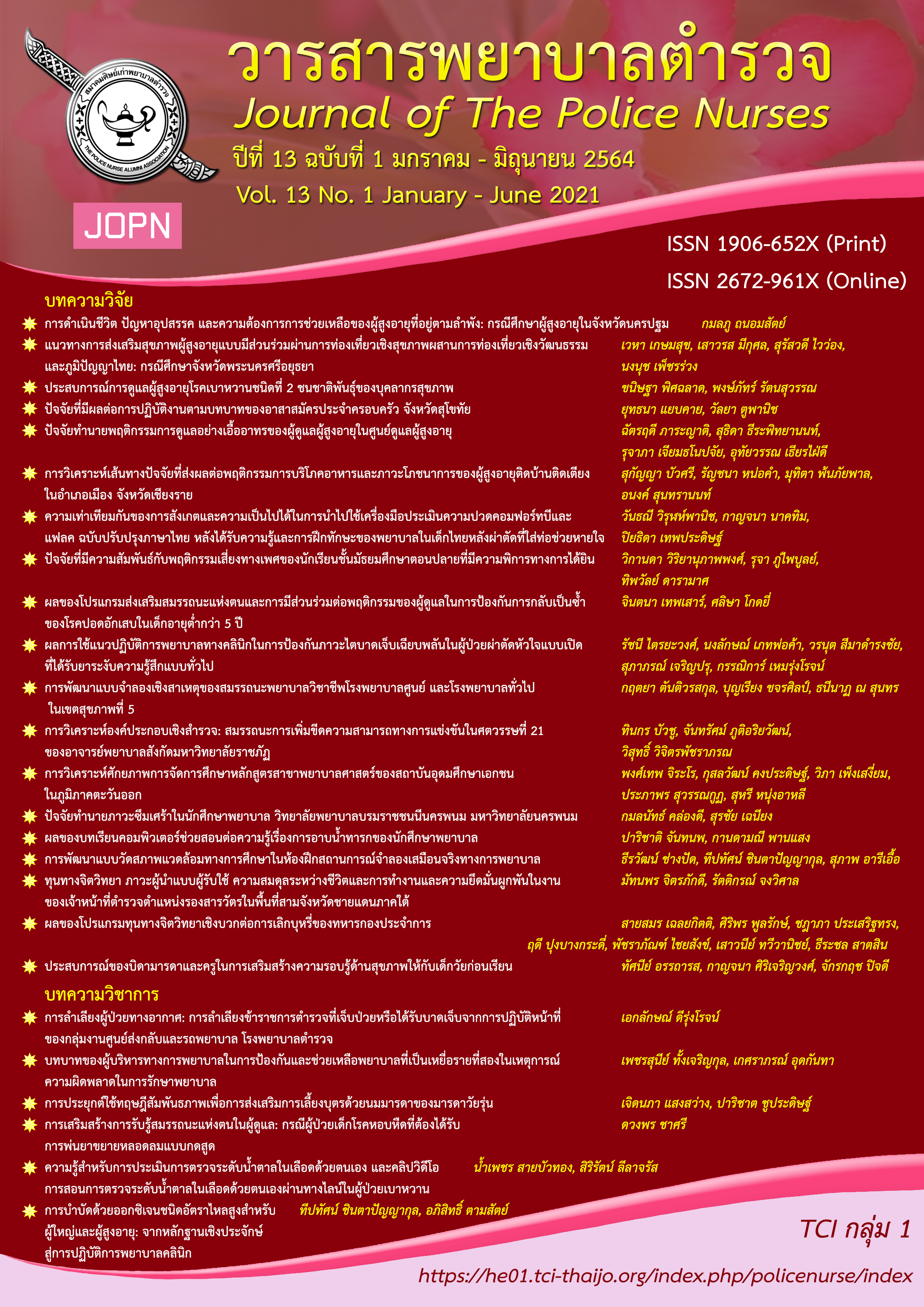THE EFFECT OF SELF-EFFICACY AND PARTICIPATION PROMOTING PROGRAM ON CAREGIVERS’ BEHAVIOR TO PREVENT RECURRENT PNEUMONIA IN CHILDREN UNDER 5 YEARS
Keywords:
recurrent pneumonia, self-efficacy, participation, caregiver behaviorsAbstract
This quasi-experimental approach aimed to compare caregiver behaviors to prevent recurrent pneumonia and re-admission rate in children under 5 years of age. Purposive samples were recruited from the caregivers in a pediatric ward. The caregivers in the experimental group (n = 26) received the promoting self-efficacy and participation program and the caregivers in the control group (n = 26) received the usual nursing intervention. The research instruments consisted of the promoting self-efficacy and participation program and questionnaires about caregiver behaviors to prevent recurrent pneumonia in children. All instruments were tested by five qualified experts with a CVI of .98 and Cronbach’s alpha coefficients of .73. Data were analyzed by using frequency, percent, range, mean, standard deviation, paired t-test, and independent t-test.
The findings of this study revealed that 1) the average of caregiver behaviors to prevent recurrent pneumonia in children after receiving the promoting self-efficacy and participation program was statistical significance higher than before (t = -18.21, p = .000) and also higher than the control group (t = 13.47, p = .000), and 2) the re-admission rates from pneumonia between the experimental group and the control group were not statistically different (p = .235).
The findings support that the promoting self-efficacy and participation program should be advertised to caregivers to prevent recurrence pneumonia in children under 5 years of age.
Downloads
References
Aree, P., Choeichit, S., Heebngern, B., & Sornmayura, P. (2019). Factors related to caring behaviors among caregivers of children with pneumonia at hospitals of zone 5 under the Ministry of Public Health. Journal of Nursing and Health Sciences, 13(4), 150-164.
Bandura, A. (1997). Self-efficacy: The exercise of control. New York, NY: W.H. Freeman.
Bunluesup, W., & Rodcumdee, B. (2015). The effect of perceived self-efficacy promoting program on preventive behavior of mothers of toddler at risk for asthma. Thai journal of nursing, 65(4), 55-62.
Cabral, C., Ingram, J., Lucas, P. J., Redmond, N. M., Kai, J., Hay, A. D., & Horwood, J. (2016). Influence of clinical communication on parents’ antibiotic expectations for children with respiratory tract infections. The Annals of Family Medicine, 14(2), 141-147.
Cohen, J. (1988). Statistical power analysis for the behavior sciences (2nd ed.). Hillsdale, NJ: Lawrence Erlbaum.
Department of Disease Control. (2019). National disease surveillance (report 506). Retrieved from http://www.boe.moph.go.th/boedb/surdata/506wk/y61/d31_5261.pdf
Fowles, T. R., Masse, J. J., McGoron, L., Beveridge, R. M., Williamson, A. A., Smith, M. A., & Parrish, B. P. (2018). Home-based vs. clinic-based parent–child interaction therapy: Comparative effectiveness in the context of dissemination and implementation. Journal of Child and family Studies, 27(4), 1115-1129.
Hockenberry, M. J., Wilson, D., & Rodgers, C. C. (2019). Wong’s nursing care of infants and children (11st ed.). St. Louis: Mosby.
Hong, E., & Yang, Y. J. (2015). Factors affecting job stress of pediatric nurses: Focusing on self-efficacy, emotional labor, pediatric nurse-parent partnership. Child Health Nursing Research, 21(3), 236-243.
Jain, S., Self, W. H., Wunderink, R. G., Fakhran, S., Balk, R., Bramley, A. M., & Chappell, J. D. (2015). Community-acquired pneumonia requiring hospitalization among US adults. New England Journal of Medicine, 373(5), 415-427.
Kaewsuk, C., Pongjaturawit, Y., & Chaimongkol, N. (2016). Factors associated with maternal behavior in prevention of acute respiratory infection in preschool children. The journal of faculty of nursing burapha university, 24(4), 54-64.
Klangka, P., Juntori, W., & Taweing A. (2019). A development of discharge planning model for pediatric patients with pneumonia using family and caregiver participation. Journal of vongchavalitkul university, 32(2), 40-49.
Marcdante, K. J., & Kliegman, R. (2019). Nelson essentials of pediatrics (8th ed.). Philadelphia, PA: Elsevier.
Nammong, J., Chivanon, N., & Wacharasin, C. (2019). The effect of perceived self-efficacy promotion program on mother’s caring behaviors for toddler with acute lower respiratory infection. The journal of faculty of nursing burapha university, 27(3), 43-53.
Niec, L. N. (2018). Parent–child Interaction Therapy: A Transdiagnostic Intervention to Enhance Family Functioning. In L. N. Niec, Handbook of parent-child interaction therapy (pp. 3-15). Springer, Cham.
Pakunglumpoo, P., & Theunnadee, S. (2018). The effects of perceived self-efficacy development program among caregivers on caring behavior and pneumonia re-admission rate in children under 5 year of age. Journal of nursing and health care, 36(3), 99-106.
Samit, J., Lamchang, S., & Mesukko, J. (2013). Information support, self-eficacy and parent participation in caring for hospitalized with acute illness. Nursing Journal, 40(4), 114-124.
Schepp, K. G. (1995). Psychometric assessment of the preferred participation scale for parent of hospitalized children. Unpublished manuscript, School of Nursing, University of Washington. Seattle: WA.
Sheehan, R., & Fealy, G. (2020). Trust in the nurse: Findings from a survey of hospitalised children. Journal of Clinical Nursing, 29(21-22), 4289-4299.
Shen, K., Yang, Y., Wang, T., Zhao, D., Jiang, Y., Jin, R., & Wang, Y. (2020). Diagnosis, treatment, and prevention of 2019 novel coronavirus infection in children: experts’ consensus statement. World journal of pediatrics. http://www.doi.org/10.1007/s12519-020-00343-7
Sueram, K., Wijitphan, W., Muangkao, B., & Samanuhat, A. (2017). Information requirement and caregiver’s participation in caring for children with pneumonia. Journal of Nursing Science & Health, 40(1), 63-76.
Threesoon, P., & Rodcumdee, B. (2017). The effects of maternal coaching program on caring behaviors for toddler with pneumonia. Journal of nursing and health care, 35(1), 55-63.
Vanichbuncha, K. (2012). Statistical analysis: Statistics for management and research (14th ed.). Bangkok: Chulalongkorn University Printing House.
World Health Organization. (2013). End preventable child deaths from pneumonia and diarrhoea by 2015: The integrated global action plan for pneumonia and diarrhoea. Retrieved from http://www.who.int/woman_child_accountability/news/gappd_2013/en/
World Health Organization. (2018). Levels and trends in child mortality report 2018. Retrieved from http://www.who.int/maternal_child_adolescent/documents/levels_trends_child_mortality_2018/en/
Zhang, S., Sammon, P. M., King, I., Andrade, A. L., Toscano, C. M., Araujo, S. N., & Booy, R. (2016). Cost of management of severe pneumonia in young children:Systematic analysis. Journal of global health, 6(1), 010408. http://www.doi.org/10.7189/jogh.06.010408
Downloads
Published
How to Cite
Issue
Section
License
ผลงานที่ได้ตีพิมพ์แล้วจะเป็นลิขสิทธิ์ของวารสารพยาบาลตำรวจ















